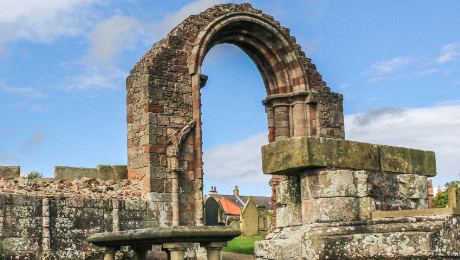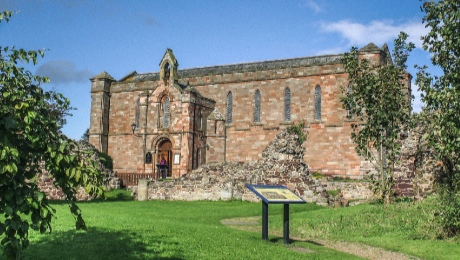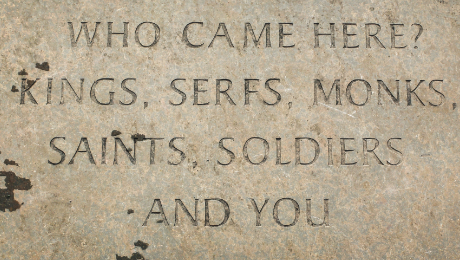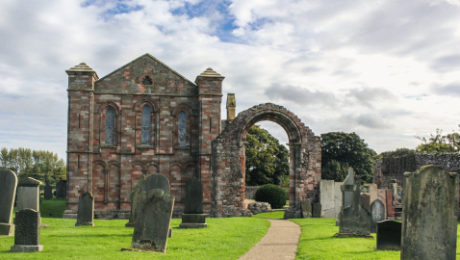After the fall of the Roman Empire, the British Isles were a patchwork of kingdoms, with an extensive cast of kings, some pagan and some trying out the new cloak of Christianity, fighting each other for more power and greater control.
Born in AD 615, Aebbe was no ordinary child: she was the daughter of Æðelfrith, a pagan warlord and King of Northumbria. He ruled from his ancestral fortress at Bamburgh, on the coast opposite the tiny tidal island of Lindisfarne. After 24 years in power, Æðelfrith was slain by his brother-in-law, Edwin, a Deiran prince whose lands lay to the south, in what is now Yorkshire east of the Pennines.
Acha (Aebbe’s mother and Edwin’s sister) rather sensibly decided to flee immediately. Would her victorious brother choose to kill her children, who were the sons and daughters of the king he’d just killed, or would he reconcile them? Acha did not wait to find out. Instead, she fled north to Scotland to seek the sanctuary of distant relatives at the court of Eochaid Buide – Eochaid Yellow-hair, in the kingdom of Dál Riata.
Aebbe converts to Christianity
At the time, Dál Riata included much of western Scotland and north-eastern Ireland. Unlike Edwin, who converted to Roman Catholic Christianity and seems to have fancied himself as a latter-day Roman emperor, the kings of Aebbe’s new home in Dál Riata were Gaelic in their cultural affinities and thoroughly Irish in their Christianity.
They fostered Aebbe and her siblings; raising her brothers to fight in their dynastic wars at home and in Ulster, and sending them to be educated on Iona, where a great monastic house had been founded by Colm Cille (Saint Columba) in about AD565. Here, the children of Acha soon converted to this firey brand of Christianity.
Aebbe returns to Northumbria
Around AD 635, Æbbe’s brother Oswald returned to Northumbria with a band of his father’s warriors, a party of Dál Riatan youngbloods and, we suspect, a band of Ionan monks, hard as nails and bristling for a fight in the true cause.
There, they regained the throne, control of Bamburgh Castle, and founded a monastery on Lindisfarne, filled with monks who followed the teachings of Saint Columba. This was the first step in the Christianisation of his people, who were still largely a pagan population.
With a safe passage home, Æbbe returned to Northumbria.
Aebbe refuses to marry
With the support of her brother, Aebbe founded her first monastery at Ebchester, on the site of a Roman fort. By then, she had already become a nun by some accounts to avoid the advances of Prince Aidan. As the story goes, she stubbornly defied her family’s wishes and fled up to Coldingham, about 25 miles past Lindisfarne. Here it seems her prayers were finally answered, and the sea rose up around her rocky refuge, blocking Aidan’s attempts to pursue her.
Coldingham is born
Aebbe soon established her second monastery at Coldingham. Unlike Lindisfarne, Aebbe’s monastery was double monastery, home to both monks and nuns, and was recorded by the name of ‘Urbs Coludi’ by the medieval historian, Bede.
It later became known as Colodaesburg in Anglo-Saxon, and then Coldingham. We don’t know the full extent of the power Coldingham had in the surrounding area, but with a royal founder and close ties to Lindisfarne, it’s likely that Coldingham was rather more influential than Bede let on in his writings.
Aebbe’s circle of influence expands
She soon became instrumental in the spread of Christianity to the still largely pagan population on the Northumbrian coast. She educated Queen Aetheldreda, the first wife of her nephew King Ecgfrith, who later went on to establish a monastery on the site that would become Ely Cathedral.
Aebbe’s political skills were also put to the test during this period. Aetheldreda, despite being married to King Ecgfrith, wished to preserve her virginity and enter a monastery. Aetheldreda was supported in her wish to join monastic life by Bishop Wilfrid, and caused tension between the royal court and the Bishop. This tension grew as Bishop Wilfrid continued to acquire large estates, and began travelling with armed guards. Things came to a head when Ecgfrith imprisoned Wilfrid, but when Aebbe heard of his imprisonment, she persuaded her nephew to release the bishop.
Aebbe loses control
What Bede does bring to our attention is that like many double monasteries, which were often inhabited by the younger offspring of noble families, Coldingham had gained a reputation of feasting, drinking and other misconduct. One night, a visiting monk warned Aebbe that he’d had a dream in which he saw that the monastery would be burned down as punishment, though not during her lifetime.
Having now gone through all this monastery in order, have looked into the huts and beds of all, and found none of them except yourself busy about the health of his soul; but all of them, both men and women, are either sunk in slothful sleep, or are awake in order to commit sin; for even the cells that were built for prayer or reading, are now converted into places of feasting, drinking, talking, and other delights
– The words of Adamnan, Bishop of Iona, to Aebbe, as recorded in Bede’s Ecclesiastical History of England
Despite Bede’s account, Aebbe herself continues to be described as a wise, pious and holy woman, and she nevertheless seems to have been held in extraordinarly high regard. She was even visited by Saint Cuthbert, Bishop of Lindisfarne, who is usually said to have avoided the company of women. And yet he visited Aebbe at Coldingham, and when he did, a miracle took place…
The miracle of Saint Cuthbert and the otters
During Cuthbert’s visit, it was said that he would leave the monastery every evening, only to return at dawn.
One evening, a curious monk decided to follow him and find out what he was doing every night. The monk watched as Cuthbert walked out into the sea until he was up to his neck in icy cold water, staying there until dawn while singing psalms to avoid succumbing to temptations of the flesh. When Cuthbert finally came back to shore, the monk witnessed a miracle: two otters emerged from the water, licking his ice cold feet until they were warm again, and drying them with their fur.
Coldingham burns to the ground
Sadly, Æbbe’s legacy was not to last. Soon after Aebbe’s death in AD 863, the monastery did indeed burn to the ground, just as Adamnan had dreamt.
What happened next is not entirely clear. According to some accounts, the monastery was eventually rebuilt, but this time it was only home to a small community of nuns, led by another abbess known as Aebbe the Younger whose attempts to resist the Vikings would make her a saint. According to others, it was abandoned and left empty.
Vikings attack
Like Lindisfarne, and many other monastic sites on the north east coast, Coldingham would have been an easy target for Viking raiders, and some accounts suggest that the community led by Aebbe the Younger was devastated less than 200 years later, in AD 870.
Since then, Coldingham has been rebuilt and destroyed again and again. It was even burned down at one stage by its own prior, William Drax, in his attempt to cover the fact he’d stolen money being transported to the king. What survives on the site today is a composite of buildings constructed between the 11th century, when a priory was founded by Edgar King of Scots, and the 18th century. Clearly, there is a lot of history on the site. The question now is finding it…





